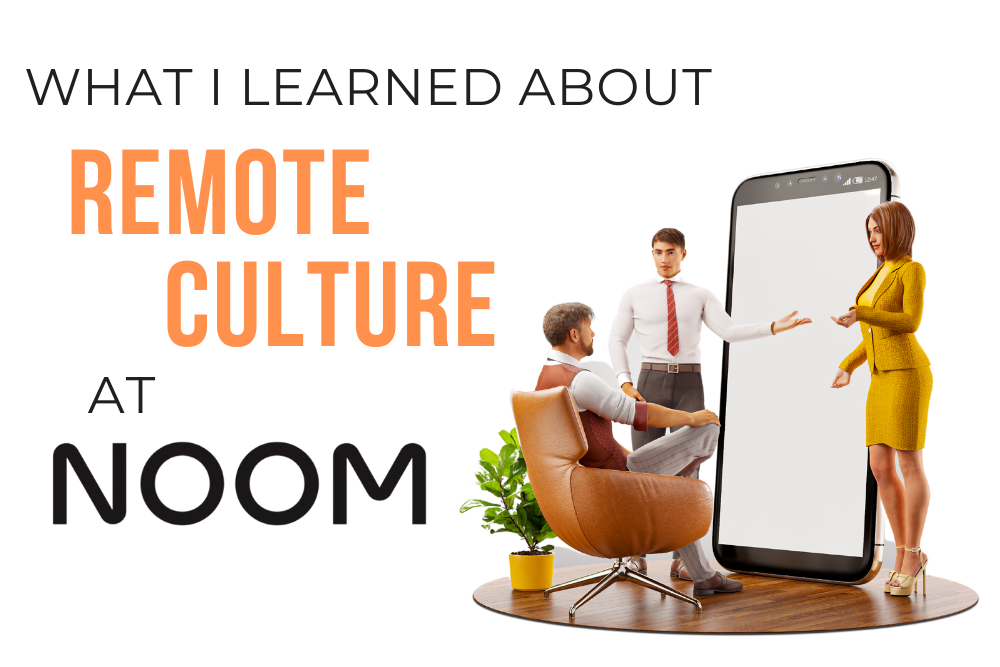Back in March of 2020, I entered a new level of adulting: getting a job with an actual salary, and actual benefits! After working my butt off for nine years to get two bachelor’s degrees and having spent all of that time–plus 10 more years after that–as a captive of hourly wage service industry jobs and multi-apping gig work, I was excited. And, I was really, really lucky. Right when a lot of folks were laid off or furloughed due to the pandemic’s long shadow, I was brought on board at Noom as a Health and Wellness Group Coach.
In this article:
- My First Remote Work Experience
- Discovering the Noom-iverse
- Onboarding & Training
- Everyday Culture
- Why It Worked
- How It Didn’t Work
- The Future of Remote Culture
My First Remote Work Experience
Noom was my first remote job. However, it wasn’t my first remote work. Back in high school, I attended a semester of an internet-based private school. Living in the boonies of Montana and not being old enough to drive, this was a solution that made sense. I was amazed to not only enjoy the somewhat self-guided learning style and attending some live and some recorded classes, but I also was thrilled that I made two really good friends, one of which became a pen pal and both still follow each other’s socials to date. All over the magic of the internet.
That semester played a part in my developed appreciation of doing meaningful work alone, yet together. It was a beginning that launched skill-honing and nuances of long-distance relationships with people I never met face-to-face. Then there was the homework that one HAD to turn in by a certain time, or the system would shut down any attempts for a late submission. So, I learned a little bit about digital deadlines and working around potential distractions at home, while stuck at home. Huh. Sounds… familiar. ?
BACK TO TOP
Discovering the Noom-iverse
Fast forward 15 years. When I was working a PT job as an animal rehab assistant for a local veterinarian in Asheville, I met a young lady who’s energy captivated me, and her dog and I fell a little bit in love. ? When Nike would come in to do water therapy with me, I and Marissa Pearrow (currently picking up her specialty again as an independent NBH-HWC certified Holistic Wellness Coach, you need a good one?), her owner, would chat away about everything. We vibed on so many levels, and we learned a lot from each other.
Sometimes Marissa would bring in her laptop and pitter away at the keyboard during the good girl’s rehab session. I was so intrigued by this grounded, intelligent and gentle human and asked her one day what she did for work, because she seemed in such alignment with her core values. She spoke so affirmingly and compassionately, yet strongly. Someone on the path to wellbeing that I desperately needed myself. Her energy was captivating, calming, and I wanted some of that.
That’s when I learned about Noom–a psychology-based weight-loss coaching* and curriculum program wrapped up in an app. It was a stepping stone for Marissa’s wellness journey to self-actualization and a way she was able to support others seeking out how to start the trek themselves. A bit of an overworked and tired jack of all trades, I was interested in becoming a fulfilled master of one.
A problematically poor philanthropist, the thought of being able to do something that helped people and would pay me to do so sparked my inner fire. Long story short, I applied, and I was hired–with a slight onboarding delay due to the entire country shutting down during my initially scheduled start date in April 2020. My entire working life changed drastically, and I entered a new industry as a text-based, writing focused health coach.
I will be forever grateful to have met Nike and Marissa. Fate brought us for a brief interlude, and that moment changed my world and opened my life to so much love and light.
*Coaching is no longer a pillar of the Noom program. It is offered, however, with a premium subscription.
BACK TO TOP
Onboarding & Training
There were many ways I wasn’t ready for the job. I struggled with my weight my whole life, I had a background in psychology but a lack of one in health sciences, I’d never coached before, and I wasn’t sure how my neurodivergence would affect my work relationships and duties.
My misgivings were valid, but Noom was prepared seemingly just for me. Post initial in-house training, Noom provided an opportunity for me to study and sit for the NBHWC (National Board of Health & Wellness) exam to get my credentials, which is awesome and of which I took full advantage. Not only that, but I learned a lot about self-care and living in a way that honored my body, mind and spirit. ?
What was great about onboarding with the large, maturing startup:
- The trainings were organized, simple, and informative
- Live, interactive and dynamic trainings hosted by senior esteemed volunteer employees utilized Zoom, Slides, and LearnUpon for asynchronous work (meaning training modules that don’t require all members to be online simultaneously) that made a clear-cut path for learning about the role and business
- The learning went beyond role aspects to educate all on company structure, different departments, “after school” type initiatives and activities, and inform of both in-house and outside supports available, both in house and out
- Mentorship: New employees were paired with a coach who had been at the company for a minimum of 9 months, in good to excellent company standing, and went through an employee-developed mentorship training series
- A conglomerate of 15 or so including a “Core” Leader (coach manager) and Core Members (coaches) made up my direct support group that functioned as my primary team, where asking questions and supporting each other was encouraged
Looking back at what made me feel so quickly welcome, it had a lot to do with the onboarding process along with the wellbeing initiatives, support groups and resources for all kinds of folk.
BACK TO TOP
Everyday Culture
- Don’t take yourself too seriously.
- Follow and evolve processes.
- Invest in your growth and let Noom invest in you.
- Clearly identify the goal, do the math and prioritize ruthlessly.
- Think like an owner.
- Care for each other like family, but act like a high performing team.
- Disagree, then commit.
- Earn and keep people’s trust.
- Optimize for fast learning.
- Be super transparent, but be kind. ?
- Mission first: Help people everywhere lead healthier lives through behavior change.
It’s hard to capture almost 3 years of experience in one go, so I’m going to lean into the highlights of what everyday culture felt like. To start with, while some aspects of the job were unclear (Noom practiced employee autonomy, almost to a fault sometimes), their overall culture was stated with intention and the expectation of employees agreeing to hold to these standards. These principles were clearly defined, setting the tone for the culture they wanted all to help sustain and evolve.
What made a big impression on me was Noom’s follow through of unwavering support to DEIB efforts. They invested in programs and put appropriately experienced people in key positions. Some other things that I feel made Noom exceptional:
They empowered employees to step up as leaders by giving opportunities to run ERGs (employee resources group), projects, and teams. A time allowance was given to workers to become involved with company-based mentorship programs, volunteer opportunities, book clubs, diversity groups, creative content, and to participate in coach-lead company wellness classes.
The four pillars of health were something that Noom not only talks about, but provided opportunities for. Examples:
- Nutrition – All employees were encouraged to use the Noom program at no cost to learn from the inside out about their famous “color system” for classifying foods as green (eat a lot!), yellow (eat some!) or orange/red (eat a bit!).
- Exercise – There was a Wellbeing Calendar for all of the Noom activities almost at rec center level. Various yoga, meditation and exercise classes were hosted on a weekly rotation.
- Sleep – Wellbeing Challenges happened almost every month with theme goals of hydration, sleep, gratitude, and step challenges in which a huge chunk of employees took part and were organized and run by employees.
- Stress – Among the live mindfulness classes, there were also resources made to us like BetterHelp, Noom encouraged and enforced a 40 hr/wk maximum of work for work-life balance, team-building exercises, social meet-up opportunities both virtual and in-person (on pause during COVID), and some inner programs for coaches & employees in crisis.
Education and growth oriented, Noom pushed you to stretch yourself. LearnUpon modules, CEU accredited classes (continuing education), and professional-growth stipends were the receipts that your growth as both an employee and person was important to them.
They tapped into how to make a remote culture a strong community. The Core was a success in my opinion, as we created bonds that lasted beyond the job and nudged into our lives. The emphasis on kind and transparent communication between all helped in resolving conflict and building rapport.
This feeling of belonging extended beyond the Core. There developed a close bond between coworkers, and maybe that was in part to the fact that I involved myself in as many spaces and opportunities as possible. I got to know a lot of teams and worked closely with individuals across the globe. From leading a DEIB ERG to piloting a post-writing program to dabbling in image creation to being an active participant in my department, I was invested. I was supported. I supported others. We were strong.
While many of us did not escape the great tech downturn and are no longer employed at Noom, you would be amazed if you had my LinkedIn newsfeed. Starting back as far as May 2021 when the layoffs began and growing mightily to today, my feed is overflowing with messages of job postings, commissary, encouragement, support, kindness. What changed? I had started adding Noom coworkers to my Connections.
I realize that in working at Noom, they really did have a culture that attracted the kindest, most genuine, strong, creative, and talented people to them. And that is something.
BACK TO TOP
Why It Worked
Both brick + mortar and digital offices have their pros and cons. Remote culture has been around for kinda a while, but it has never seen such expansion as it has since 2020. Many industries are trying to define what our new normal should look like. We’re entering the Age of the Virtual Office, and taking input from those in your corporation can serve to get through the aches of breaking in the new fit more quickly by identifying pain points and brainstorming solutions.
These things I think are key to fostering a remote culture that works:
- Flexible meeting practices that require active participation: optional camera, chat utilization vs. unmuting, normalizing stepping away to deal with WFH issues (kids, pets, etc.)
- Use “pulse check” surveys check in on employee satisfaction their work, load, communications, support, and other company aspects
- Invite personalization the work experience with memes and SFW custom emojis ????? (you know you wanna)
- Dedicate spaces for belonging/employee support networking, like Slack groups and ERGs
- Consistent, meaningful communication between all employees and departments
- Encouraging fun and connection, and providing such opportunities
- Company follow-through on employee well-being initiatives
- Having a unambiguous mission and defined purpose
- Providing the resources for employees to succeed
- Clear communication and reasonable requests
- Cultivating a culture of trust and respect
- An emphasis on employee growth
One big point: Remote work simply doesn’t work if you don’t have your ear to the ground. Noom sent surveys regularly to staff to ensure they feel connected to their colleagues and the company culture. Additionally, there were bi-weekly company-wide virtual team meetings with corporate facetime, monthly virtual social events, and opportunities for formal and informal interactions between coworkers and anyone in the head office. No one was too good to talk to anyone else. As an entry-level employee, the door was open to chat with the CEO. There was a common thread of trust that weaved through the company.
Regardless of the fact that Noom had a complete restructuring that included a significant reduction in force, I can’t help but wonder what it would have been like to continue in that environment. Over 4,000 people working together remotely as a synergetic team with a collective beating heart is no small feat to develop, and Noom did it.
Of course, not everything was sublime–far from it. However, I have a bit of perspective. Having worked over 30 retail, service, construction, field work and gig jobs, I’ve had exposure to a pretty plethora of work cultures and environments. And although Noom wasn’t perfect, there was obviously a lot of effort and mindfulness put into crafting the culture.
BACK TO TOP
How It Didn’t Work
Although my experience and that of many others I’ve spoken with was overall positive, I must acknowledge that wasn’t the same for everyone. Things did slip through the cracks, and errors were made. Some of that is the natural swell and wane of running a large company, and some had to do with the remote nature of the work.
Some people still felt isolated. Although there were multiple groups and supports available, not everyone felt like they could or should take advantage of them, if they knew about them. So there was a problem with having a complete workforce made aware of resources. Additionally, not all managers are created equal, and some employees didn’t feel confident about asking for help or admitting they were overwhelmed.
Distractions at home could get a bit much. Beyond Noom’s reach, disruptions in the home can make it difficult to track exact hours worked or meet certain metrics, like X amount of messages sent per hour. Although the staff was more than capable of finishing their job, and well, crying kids or spousal interruptions (especially those who don’t get that remote work doesn’t mean you can talk whenever you want) etc. made meeting micrometrics difficult.
Work-life balance could get out-of-whack. When your place of work is the same table where you eat dinner, lines can blur in your mind about when is appropriate to work and when is appropriate to be your “home self.” Like how the cellphone made it almost too easy to reach anyone at any given time instead of leaving a message on the home answering machine, having your job take place in your living room can cross wires. Having boundaries is very important to avoid burnout, and this MUST be enforced and led by the example of company leaders. Committing to times for working, receiving Slack notifications, and responding to emails have their place.
Company resource, tools, communication and document disorganization kills productivity. This was something that Noom consistently was working to improve, which was greatly appreciated and made a big difference. If you don’t have a person or team in charge of selecting project management tools, coming up with procedures that are clear, and lack a directory of channels employees can go to get their questions answered, your remote company will likely produce sluggishly and/or increase the stress of employees. Collaborative tools also go a long way in helping folks work together and support one another.
BACK TO TOP
The Future of Remote Culture
If you ask me, unless there’s a solar flare that disables all modern technology and sends us back in time with our tools, remote work is here for the long-haul. But you don’t have to just take my predictions as proof–studies are revealing that remote work is more than a potentially viable option for many companies to invest in.
That’s good news for businesses looking to reduce overhead costs, as having a smaller head office vs. a large one or multiple locations is cost-effective. Additionally, it benefits workers as well as productivity. Airtasker surveyed 1,004 full-time employees–just slightly over half being remote employees–of businesses across the U.S. Their work habits and productivity as the focus, the results show that remote workers are actually more productive than their office-based counterparts. Some specific findings from the study include:
- Remote employees work an additional 1.4 more days per month than in-office employees, which is nearly 17 additional workdays a year.
- This can be good and not so good. If an employee feels under the weather but still wants to work, they can without fear of passing it to office mates. It also demonstrates the possibility that folks feel more obligated to work when they house their own work environment.
- Remote employees take longer breaks on average than office employees, but they work an additional 10 minutes a day overall.
- So, the breaks are more fulfilling and rejuvenating. Is it the number of minutes, or being able to engage in meaningful breaks that make this happen? Both?
- 15% of remote workers said their boss distracted them from work, which is less than the 22% of office-based employees who said the same thing.
- Watercooler talk has long been a source of bonding in office spaces, and it should and can continue in the Virtual Office. However, other unwelcome irrelevant disruptions are notably reduced in the remote space.
While this is a small sample of how shifting your affair with your company to a long-distance relationship can benefit a lot of folks and company productivity, there are still a lot of unknowns. Does your establishment include or is considering introducing remote options? Why do you feel like it works, or why it won’t? Let us know!





